Grafting utopias
The annual festival of Delhi’s oldest architecture school is called Utopia. When I ask the students why it is called so and if they know what it means, they look confused. One exclaims, ‘Utopia is what we will create… it’s the perfect place, the perfect city…’ So I ask them, ‘But does it exist? And if it does, where is it?’
Generation after generation of architecture school students are fed on the idea of architects as the creators of perfect houses, cities and townships. They are taught about master plans that will save the world, from itself; they are trained to build townships with glimmering sharp-edged buildings, which no one can clean; they are taught about the deliverance of the world through architecture. This could be a deliverance based on emulating the glass facade high-rises of Dubai, London, Shanghai or the dull concrete corridors of Cold War era buildings across South Asia, Eastern Europe and the erstwhile USSR. Such prototypes reflect a deep and determined utopian imagination that continues to be entrenched in architectural planning and practice. Modernism and brutalism made a promise, a social contract of being architecture for the people, for their needs. Yet they failed in many ways either through buildings that people cannot use or those to which people have to fit themselves.
Is modernist architecture adaptive or normative? Can it accommodate the expansions of desires and the accumulation of years? Does it fabricate buildings for people or people for the buildings? The utopian world delivered by architecture or ‘the city of the future’ as Corbusier called it was believed to have the power to get rid from the world all its social evils. This imagination needed a frame that could avoid the disorder of the real world and yet be perfect in totality. The modernist plan was precisely this frame, which provided relief to architecture’s anxieties about the chaotic world. The axiom of the modernist frame—‘perfect cities make perfect citizens’—allowed architecture to not have to engage with the disorderliness of the social at all and superimpose the idea of a utopian future in blueprints and master plans, which could actually never be implemented in entirety but perfected and completely controlled in their internal form.
Of architectural anxieties
Three main anxieties have continued to haunt architecture: first, the presence of human beings; second, how to control humans and their actions; third, who will be the master controller (planner) of the future. Where are these anxieties coming from?
The Western hermeneutical canon at some point gets obsessed with the ‘forgetting of being’ because the world is too alienating, a world continuously being transformed and devastated by technologies of production and of war. Something or some essence of life had been lost in this world. Anxieties about the loss of a familiar world and the forgetting of being get reflected in different ways in the works of Martin Heidegger and Walter Benjamin. Benjamin’s forms of reclaiming the lost world were through an obsessive archiving of the everyday, whether it was a fleeting eye contact with a stranger or looking at the window of an old antique shop. Heidegger’s turns are more dramatic. He attempts to reclaim the idea of the essence of being, landing him, on the one side, with the technology-driven totalitarian regime of Nazism and, on the other, in the pure, primeval world represented by the isolated hut in the forest.
What can be the relationship between philosophical thinking and forms of building and architecture? Modernist architecture and its various styles including Bauhaus, brutalism and structural expressionism all feed on and are a response to the ontological anxieties of thinking, being and loss. Through its starkly functionalist solutions and industrial and technological aesthetics, modernist architecture uses defamiliarization as a tool to make the loss and forgetting of being more complete and final.
One of the primary anxieties that I encountered in architectural practices and pedagogies was that of the presence of human beings. As if the whole discipline had been blinded by the forgetting of being or beings and now had to suddenly learn to cope with or dodge humans in all their complexities and multiple manifestations. This anxiety is actually inculcated inside the classroom in what we call the studio class of architecture. Year after year, students are put through the drill of working on models, which are made of cardboard, thermocol and other such materials, having no connection with materials from which houses are actually built. Creating perfect models takes over the pedagogy and learning of architecture. The default mode is then to focus on forms of measurement and perfecting models, rather than learning about who and what will come to inhabit these structures. Perfectly cut Styrofoam walls in Euclidian forms come to define the meaning and function of architecture in the imagination and work of students. Slowly, the whitewash of the brain happens, where the imagination of students starts limiting itself to these Styrofoam walls, devoid of any life, of scratches, paintings, posters or drawings of a child. These walls of the mind sit in perfect equidistance; they are not weathered by seepage or the growth of moss; they will never be broken to expand rooms; the winter sun and the summer sun will always be the same on these walls.
Richard Sennett, in his book The Craftsman (2008),[1] discusses how the shift from hand-drawn plans to computer-assisted design has led to a situation where architects don’t even have to visit sites, making the plans entirely devoid of contexts, whether relating to built and social environments or something as basic as the weather. Designs can thus be executed through computer software and then sent across for implementation, fracturing the intimate connection between the head and the hand. The blueprint as a sacred and complete design in itself, which only needs implementation rather than improvisation, has another consequence—it obliterates labourers from their role in making as also their skills. It also fractures the relationship between the architect and forms of labour, as reflected in Zaha Hadid’s statement about migrant workers’ deaths in Qatar: ‘I have nothing to do with workers.’ For her, the workers’ deaths though unfortunate were unrelated to her ‘duty as an architect’.[2]
Architecture’s anxiety about the presence of human beings and their lives is also reflected in architectural photography. In fact, the first question I asked Mila about his Instagram account on Delhi modernism was: ‘Why have you deleted the people?’ Architectural photography, as other forms of visual representation of architecture, becomes as much a part of the production of architectural work as the work itself. How buildings are photographed, represented and imagined reveals to us not just an aesthetic but also an epistemology of understanding, learning and doing architecture. There is an entire genre of films on modernist architecture, where all one sees are empty buildings, images of the plans of the buildings and their cross-sections, and the play of light on the buildings sans people. It’s like the transcendent feeling evoked through this cinematic form wishes to take you back to some sacrality of architecture’s essence, much like a moment of Heideggerian return. Yet again, there is no conversation on the dust that settles, the weathering, the repair of walls and those who will one day be employed to clean the buildings.
The emphasis on form, structural elements and functionalist aesthetics in modernist and brutalist architecture, which is reproduced in its visual representations, conceals its actual uses, erosion, ageing and everyday lives of habitation. Mila in his essay asks, ‘But does their form have an essence?’ My response to him would be more questions: What are we looking for? Is it a fetish or a monument? How do we love in a 2BHK? Is the essence concrete and grey or a life well lived between parking lots and balconies? Are we living it or bypassing it? What is the essence of any form?
Even as architectural practice has overwhelmingly become about perfecting the form rather than negotiating with life, the seepage of human life is inevitable. The room, the office, the house and the city will be inhabited; the humans will move in; and they will have to be controlled. Whether it was the death of the street in Brasília’s master plan or the structure of Delhi’s public office buildings created as part of post-independence India’s nation-building project, the form of modernist architecture has centred around the anxiety of controlling humans and their actions. Looking at iconic modernist buildings in Delhi, such as Vikas Minar, the New Delhi Municipal Corporation (NDMC) building (Palika Kendra) and Indraprastha Bhawan, one wonders whether the bureaucratic state could have been rendered in any other form.
The NDMC building rises above other buildings in its vicinity with its towering presence, alienating those forms of habitation and architecture that have existed in the area for decades or centuries. Whether it is in relation to Jantar Mantar or Connaught Place, the old Hanuman Mandir or Bangla Sahib Gurudwara, the NDMC building makes a spectral assertion to the skyline of Delhi, an assertion of its architectural distinctiveness, an assertion of the bureaucratic state’s power, as also of disjuncture from the past and the present of the city.
Cloaked in the form of containing the clerical life, public buildings such as these have erased spaces of leisure or conversation, hoping to confine its employees to spaces of surveillance and productivity. There is always a plan inside or outside buildings of such kinds—how do we keep people under control. But then is form always effective? Are the people working in these modernist buildings really just a version of Kafka’s clerk? Or is there something about the form of these office buildings itself that makes people want to escape them, to idle away on pavements and around cigarette shops and tea stalls? Is there something about the perfectly white and right-angled corners of stairways that invites people to spit paan on them? Will the bureaucratic state ever be able to render a complete plan in these reinforced cement concrete offices?
At a recent visit to IIT Delhi, I was working with my students to understand the space through its centres and peripheries. The building in the middle was like a citadel, surrounded by both real and imaginary security and surveillance. As one moved away from the centre, new worlds emerged—people smoked in the bylanes; there were birthday parties being celebrated; there were discarded beer bottles on roof tops; there were spaces of sociality around chai stalls and all-night dhabas. As I taught the students more about citadels and the form of the panopticon, and how society is defended by controlling its centres and corners, we wondered about what is so dangerous about street corners and what is reassuring about creating more and more ‘towers’ of surveillance. What fears get translated in modernist architecture and how effective is it in its attempts at control? Do we fit our lives into buildings and rooms as they have been planned for us, or do we improvise, navigate, offset and destroy the boundaries, walls and designs that are meant to regulate our ways of living?
Rooms are never finished[3]
In his book Deewar mein ek khirkee rahti thi Vinod Kumar Shukla, opens out the frame of lives lived, worlds inhabited, through the idea of a window. The window in the house of the protagonist Raghuvar Prasad sees many things, opens itself to many things passing by and also frames many aspects of the protagonist’s life. The window has for long functioned as a literary and cinematic trope—it provides a frame to view the outside and also allows the world outside to peer back in. Windows, the perfectly innocent squares of architectural drawings, have sometimes been used as a surveillance device of the state and society; sometimes they are mere accessories of an architectural facade; and sometimes they are entirely blocked and forgotten behind coolers and air conditioners. But windows also bring into view horizons, real and imagined; they sometimes keep hope alive (‘The last leaf’); and sometimes they just bring fresh air into the stuffy kitchens of patriarchy. Shukla’s novel makes you see the window itself as alive, brimming over, looking back at prying neighbours and waiting for loved ones.
The human compulsion for frames is a complex one. Whether it is architectural practice or everyday life, the need for frames is omnipresent. We dwell in ordering or in seeking to achieve order—through boxes that hold things in, wardrobes with neat rows of clothes, linear shelves with books arranged at perfect right angles. We are constantly aspiring for order, rows of houses with equidistant parking lots and equidistant relationships. But all ordering has the possibility of disorder seeping in. Life is as unpredictable as the appearance of seepage on the wall—you never know where or how it appears and spreads.
For me, a room is never complete till my bookracks are set up, classified on the basis of different themes—Sri Lankan fiction, the women poets, history of science, Sufism and Mahayana Buddhism. Yet, sometimes the women poets land up in Mahayana Buddhism, and the history of sexuality gets mixed up in the history of science. It is in this polymorphous perversity that the order of things are infinitely classified and reclassified. It is within these continuous classifications of inhabiting lines, squares and corners that the folds of meaning, relevance, love and the holding of things dear emerges. Wall sections, slope sections, floor sections interlock into frames of living, with their joints rimming over with saturations of life, upholding their own images and appearances and ours too. How then do we know that a room is complete? The architect’s room is always complete, but the lived room always has other plans.
Recently, I moved into a 2BHK Delhi Development Authority (DDA) flat. The 2BHK has been the architectural enunciation of ‘hum do, hamare do’, with the ideal family being a heteronormative one, comprising husband, wife and two children. The kitchen in the 2BHK is built to some notion about the size of the average ‘Indian woman’—the height of the sill to put the gas stove and that of the racks for storage. One wonders whether the DDA kitchens have been designed for north Indian food norms—there is space to roll rotis but where is the space to put an idli grinder? Poorly ventilated, these kitchens have not been planned for Delhi summers. Were these designed thinking of a lone woman toiling away in them for the family? Nikhil Rao in House, But No Garden (2012)[4] writes about how the floor plans of apartments built in Matunga in Bombay in the 1950s and ‘60s catered to Tamil Brahmin caste biases, with bathrooms located in such a way that cleaners would not have access to the main rooms of the house. The modernist apartment design is hardly secular—it is a reflection of gender, caste and other social structures.
Irrespective of the agendas that structure rooms and houses, they are continuously caught in processes of making. Bernard Rudofsky, fascinated by how people build and inhabit cities, streets and houses, conceptualizes improvisation as a user’s craft. Life carrying on, not grafted in the precision of the architect’s plan, contends with how houses live and how people build themselves. There is a continuous flow of improvisations and conversations between built spaces and life. Tiles come up on concrete facades because they are easier to clean; chhajjas are put up to make sure the monsoon rain doesn’t flow in; balconies expand to make way for plants, pickle jars and washing machines; carpets brought from Jerusalem battle weathering and dust. For architects, rooms and houses are finished once rendered in architectural drawing or eventually in built form. They are often uneasy about seeing their buildings improvised and altered over time. However, in some cases improvisation is built into the plan itself. For instance, once Charles Correa joyfully exclaimed at a talk in Bombay about how the Belapur housing colony designed by him had transformed itself over years of habitation. His plan was meant to be amenable to incremental construction and had served this end, being adaptable to people’s lives, the continuity of families, movements, births and deaths.
But buildings are also prone to both dogmatism and ageing, much like human life.
I had spent a large part of my life in my parents’ house in an apartment complex designed by Raj Rewal. When I recently shared this with him, he asked me how the experience had been. ‘It was difficult,’ I said. The nine-storey apartment block in which we lived was an architectural feat in its time. I had not seen a taller building when we moved here in 1986—it seemed magical and grand, like a castle in the sky to my childish eyes. Later, when I returned to live there in my thirties, it was a daily battle to negotiate life in the apartment. The maintenance costs of the pipelines were soaring; there were cracks in the beams; seepage travelled from room to room; and my mother was fast aging in the darkness of the aging house’s rooms, which were cold and dark in winters and warm and sluggish in summers. The building had aged to a point where repair was not feasible. Beams could not be broken, new rooms could not be forged, new windows could not be built—the house, like the apartment complex itself, was closed in on itself, having no where to grow now.
There is a fold between the interior and exterior, my old weathering building and my old weathering mother. May be it would have been better for her bones to have had a veranda or a larger balcony; may be her frangipani needs more sunlight now just as she does; maybe this apartment can no longer be reassembled to suit her age. And, yes, sometimes apartments are as difficult as mothers.
Bernard Tschumi has argued that architecture is not just form and space but a continuously evolving relationship of space with the coming together of events, actions and movements. Is architecture about architects or is it about people? Did architecture ever deliver its utopias? Can an idea provide deliverance? Can cubicles, offices, street plans, 2BHKs, plumbing fixtures, balconies and windows deliver us to a perfect life? Are rooms ever finished? Do they have expiry dates?
We know better that nothing lasts forever—not buildings, not us and not even love. Yet in our frail lives, we linger over soft windows, watching and waiting for that one beloved to return, for life to go on, for there to be a roof on our heads and a room of one’s own.
—Sarover Zaidi, with Samprati Pani
Cover image, ‘When was modernism’, © Sarover Zaidi. All photographs, unless mentioned otherwise, © Sarover Zaidi.
The rendering of this piece would have been impossible without Samprati Pani. From working through ideas, walking together and many, many conversations, to writing, rewriting, editing and crafting the final form, it was all done by Samprati. She is the labourer, the draughtsman, the brick and mortar of this piece. I would like to especially thank her for her time, energy and of course patience. I would also like to thank Parul Kiri Roy for giving me the first chance to teach in an architectural studio; my students and colleagues at the Jindal School of Art and Architecture; Randhir Singh and Mila Samdub for photography conversations, and Shubh Mohan Singh and Zarine Khan for being so generous with sharing photographs.
[1] Sennett, Richard, 2008. The Craftsman. New Haven & London: Yale University Press.
[2] See https://www.archdaily.com/480990/zaha-hadid-on-worker-deaths-in-qatar-it-s-not-my-duty-as-an-architect, accessed on 23 April 2019.
[3] This section title is taken from the title of a poem by Agha Shahid Ali.
[4] Rao, Nikhil. 2012. House, but No Garden: Apartment Living in Bombay’s Suburbs, 1898–1964. Minneapolis: University of Minnesota Press.

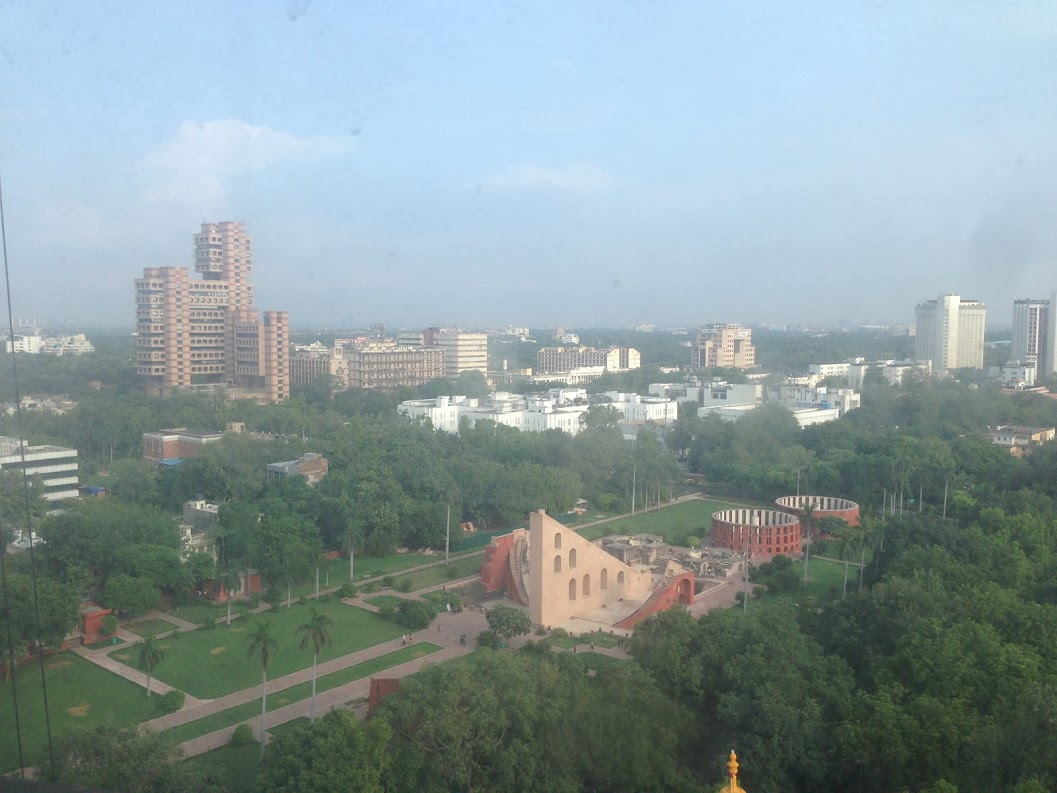


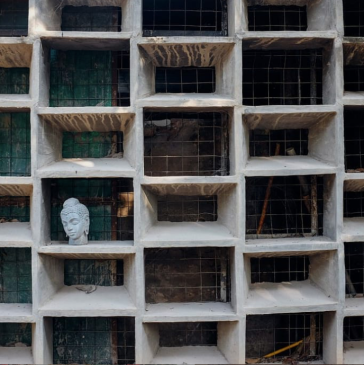
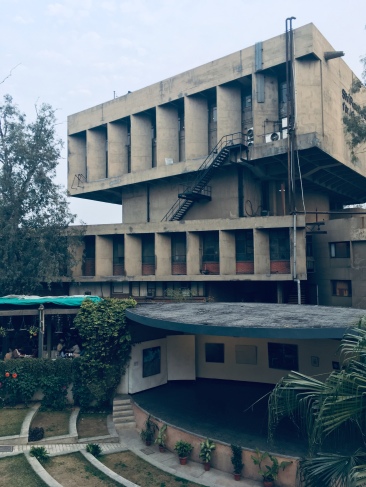


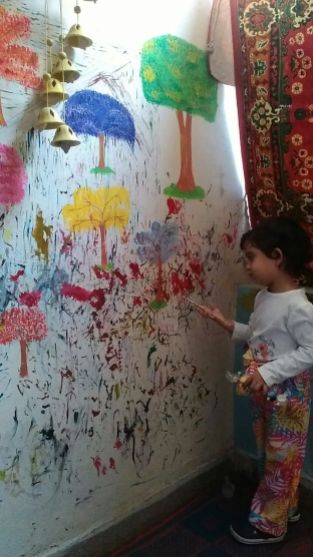






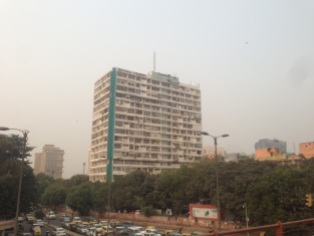


















the anxiety of controlling humans and their actions….
everything is “chipka hua” in delhi.
one house to another
one room to another.
there should be corridors between walls,
distances, spaces…
Thank you Sarover. Enjoyed reading the article. as buildings came up in images, so did memories…
LikeLike
Fabulous.
LikeLiked by 1 person
“the lived room has other plans” … beautifully written!
LikeLiked by 1 person
Enjoyed your article – every bit of it. Have we met? If not, it would be good to meet some time and discuss how a disordered space could be ‘planned’ to accommodate changing needs and visions and, perhaps, from the view of the labourer and the resident?
LikeLiked by 1 person
Beautifully written. Concrete Jungle is what Delhi is. Born and brought up here. Seen it deteriorate.
Dilli kahan gai tere koochon ki raunakein
Galiyon se sar jhuka ke guzarne laga hoon main
LikeLike